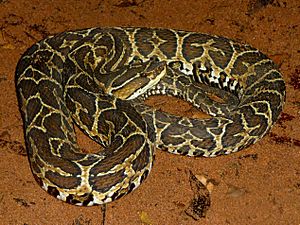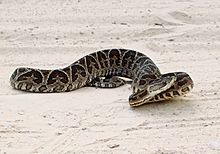Bothrops alternatus facts for kids
Quick facts for kids Bothrops alternatus |
|
|---|---|
 |
|
| Scientific classification | |
| Genus: |
Bothrops
|
| Species: |
alternatus
|
| Synonyms | |
|
|
The Urutu (scientific name: Bothrops alternatus) is a type of pit viper snake. It is known for its strong venom and is found in parts of South America, including Brazil, Paraguay, Uruguay, and Argentina. The name alternatus comes from Latin and means "alternating," which describes the cool, staggered patterns along its body. This snake is an important species to know about in the areas where it lives.
Contents
What Does the Urutu Look Like?
How Big Do Urutu Snakes Get?
The Urutu is a large and sturdy snake. While some reports say it can grow over 2 m (6.6 ft) long, the longest confirmed length is about 169 cm (67 in). Most Urutu snakes are usually between 80–120 cm (31–47 in) long. Female snakes are typically longer and heavier than males.
Urutu Snake Colors and Patterns
The Urutu snake has a very unique and changing color pattern. Its main body color can be brown, tan, or gray, sometimes with a hint of olive green. The top of its head is often dark brown or almost black, with lighter tan or white stripes.
On its body, the snake has 22 to 28 dark brown or black markings. These markings are outlined with a cream or white color. They can either line up or alternate along the snake's back. Each marking often widens and looks like a cross, or it might have a darker spot inside, or even look like a headphone shape. Near the tail, these patterns join together to form a zigzag design. Some snakes have such dark patterns that it's hard to see the difference between the markings and the spaces in between. The underside of the snake usually has a dark stripe running from its neck to the tip of its tail.
Other Names for the Urutu Snake
The Urutu snake is known by several common names, including Urutu, Wutu, and Crossed Pit Viper. The names urutu and wutu refer to the crescent-shaped markings on its body.
In Argentina, people call it víbora de la cruz (which means "cross viper") and yarará grande ("large yarará"). In Brazil, it has many names like boicoatiara, cruzeira, and urutu. In Paraguay, it's known as mbói-cuatiá and yarará acácusú. In Uruguay, it's called crucera and víbora de la cruz.
Where Do Urutu Snakes Live?
The Urutu snake is found in southeastern Brazil, Paraguay, Uruguay, and northern Argentina. In Argentina, you can find it in many provinces, including Buenos Aires, Córdoba, Corrientes, and Santa Fe.
What Kind of Places Do Urutu Snakes Like?
Urutu snakes live in tropical and semi-tropical forests, as well as temperate forests. They especially like wet places like marshes, swamps, and areas near rivers. They are also often seen in sugarcane fields. These snakes can live in different types of environments depending on the area, including open fields and rocky areas. However, they usually avoid very dry places.
How Do Urutu Snakes Reproduce?
Female Urutu snakes give birth to live young. The number of babies depends on the size of the mother. Studies have shown that a female can have anywhere from 1 to 26 young at a time. When they are born, baby Urutu snakes look just like the adults, but their colors are often brighter. Even when they are very young, newborn Urutu snakes are able to deliver a venomous bite right away.
Urutu Snake Venom
The Urutu snake is known for its venom, and its bites are an important concern in the areas where it lives. While bites are rarely deadly, they can cause significant local damage to the body.
When someone is bitten by an Urutu snake, they will almost always experience pain and swelling in the area. Other effects can include problems with blood clotting and sometimes bleeding, often from the gums. In some cases, the skin might blister. Thankfully, specific antivenin (a medicine that fights venom) is available and is used to treat bites. When antivenin is given, it helps people recover and prevents serious harm. It is very important to get medical help right away if someone is bitten by an Urutu snake.
See also
 In Spanish: Yarará para niños
In Spanish: Yarará para niños


